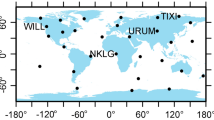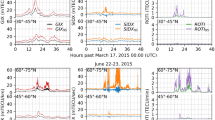Abstract
Higher-order ionospheric (HOI) delays are one of the principal technique-specific error sources in precise global positioning system analysis and have been proposed to become a standard part of precise GPS data processing. In this research, we apply HOI delay corrections to the Crustal Movement Observation Network of China’s (CMONOC) data processing (from January 2000 to December 2013) and furnish quantitative results for the effects of HOI on CMONOC coordinate time series. The results for both a regional reference frame and global reference frame are analyzed and compared to clarify the HOI effects on the CMONOC network. We find that HOI corrections can effectively reduce the semi-annual signals in the northern and vertical components. For sites with lower semi-annual amplitudes, the average decrease in magnitude can reach 30 and 10 % for the northern and vertical components, respectively. The noise amplitudes with HOI corrections and those without HOI corrections are not significantly different. Generally, the HOI effects on CMONOC networks in a global reference frame are less obvious than the results in the regional reference frame, probably because the HOI-induced errors are smaller in comparison to the higher noise levels seen when using a global reference frame. Furthermore, we investigate the combined contributions of environmental loading and HOI effects on the CMONOC stations. The largest loading effects on the vertical displacement are found in the mid- to high-latitude areas. The weighted root mean square differences between the corrected and original weekly GPS height time series of the loading model indicate that the mass loading adequately reduced the scatter on the CMONOC height time series, whereas the results in the global reference frame showed better agreements between the GPS coordinate time series and the environmental loading. When combining the effects of environmental loading and HOI corrections, the results with the HOI corrections reduced the scatter on the observed GPS height coordinates better than the height when estimated without HOI corrections, and the combined solutions in the regional reference frame indicate more preferred improvements. Therefore, regional reference frames are recommended to investigate the HOI effects on regional networks.

















Similar content being viewed by others
References
Altamimi Z, Collilieux X, Métivier L (2011) ITRF2008: an improved solution of the international terrestrial reference frame. J Geod 85(8):457–473
Bassiri S, Hajj GA (1993) Higher-order ionospheric effects on the global positioning system observables and means of modeling them. Manuscr Geod 18:280–289
Blewitt G (2003) Self-consistency in reference frames, geocenter definition, and surface loading of the solid Earth. J Geophys Res 108(B2). doi:10.1029/2002JB002082
Blewitt G, Lavallée D (2002) Effect of annual signals on geodetic velocity. J Geophys Res 107(B7):ETG 9-1–ETG 9-11
Blewitt G, Lavallee D, Clarke P, Nurutdinov K (2001) A new global mode of earth deformation: seasonal cycle detected. Sci 294(5550):2342–2345. doi:10.1126/science.1065328
Blewitt G, Altamimi Z, Davis J, Gross R, Kuo CY, Lemoine FG, Moore AW, Neilan RE, Plag HP, Rothacher M, Shum CK, Sideris MG, Schöne T, Tregoning P, Zerbini S (2010) Geodetic observations andglobal referenceframe contributions to understanding sea-level riseand variability. In: Church JA, Woodworth PL, Aarup P, Wilson WS (eds) Understanding sea-level rise and variability. Wiley-Blackwell, Oxford, pp 256–284
Clarke PJ, Lavallée DA, Geoff B, Tonie VD (2007) Basis functions for the consistent and accurate representation of surface mass loading. Geophys J Int 171(1):1–10
Collilieux X, Altamimi Z, Coulot D, van Dam T, Ray J (2010) Impact of loading effects on determination of the international terrestrial reference frame. Adv Space Res 45(1):144–154
Dong D, Dickey JO, Chao Y et al (1997) Geocenter variations caused by atmosphere, ocean and surface ground water. Geophys Res Lett 24(15):1867–1870
Dong D, Fang P, Bock Y, Cheng MK, Miyazaki S (2002) Anatomy of apparent seasonal variations from GPS-derived site position time series. J Geophys Res 107(B4):2075
Dong D, Yunck T, Heflin M (2003) Origin of the International Terrestrial Reference Frame. J Geophys Res 108(B4). doi:10.1029/2002JB002035
Farrell WE (1972) Deformation of the earth by surface loads. Rev Geophys 10(3):761–797
Freymueller J (2009) Seasonal position variations and regional reference frame realization. In: Drewes H (ed) International association of geodesy symposia on geodetic reference frames, vol 134. Springer Verlag, Berlin, New York, pp 191–196. doi:10.1007/978-3-642-00860-3_30
Fritsche M, Dietrich R, Knöfel C, Rülke A, Vey S, Rothacher M, Steigenberger P (2005) Impact of higher-order ionospheric terms on GPS estimates. Geophys Res Lett 32(23):L23311
GarciaFernandez M, Desai SD, Butala MD et al (2013) Evaluation of different approaches to modeling the second order ionospheric delay on GPS measurements. J Geophys Res 118(12):7864–7873
Goebell S, King MA (2011) Effects of azimuthal multipath asymmetry on long GPS coordinate time series. GPS Solut 15(3):287–297
Hernández-Pajares M, Juan JM, Sanz J, Orus R (2007) Second-order ionospheric term in GPS: implementation and impact on geodetic estimates. J Geophys Res 112:B08417. doi:10.1029/2006JB004707
HernándezPajares M, Aragón-Ángel À, Defraigne P et al (2014) Distribution and mitigation of higherorder ionospheric effects on precise GNSS processing. J Geophys Res 119(4):3823–3837
Herring TA, King RW, McClusky SC (2010) Introduction to GAMIT/GLOBK, release 10.4. Massachusetts Institute of Technology, Cambridge
Hoque MM, Jakowski N (2008) Estimate of higher order ionospheric errors in GNSS positioning. Radio Sci 43:RS5008. doi:10.1029/2007RS003817
Jäggi A, Beutler G, Hugentobler U (2005) Reduced-dynamic orbit determination and the use of accelerometer data. Adv Space Res 36(3):438–444
Jiang W, Li Z, van Dam T et al (2013) Comparative analysis of different environmental loading methods and their impacts on the GPS height time series. J Geod 87(7):687–703
Jiang W, Deng L, Li Z et al (2014) Effects on noise properties of GPS time series caused by higher-order ionosphericcorrections. Adv Space Res 53(7):1035–1046
Jiang W, Deng L, Li Z (2015) Highorder Ionospheric Effects on GPS Coordinate Time Series. Satellite Positioning - Methods, Models and Applications
Jin SG, Wang J, Park PH (2005) An improvement of GPS height estimates: stochastic modelling. Earth Planets Space 57(4):253–259
Kedar S, Hajj GA, Wilson BD, Heflin MB (1829) The effect of the second order GPS ionosphericcorrectionon receiver positions. Geophys Res Lett 30(16):2003. doi:10.1029/2003GL017639
Langbein J, Johnson H (1997) Correlated errors in geodetic time series: implications for time-dependent deformation. J Geophys Res 102:591–604
Langbein J (2008) Noise in GPS displacement measurements from Southern California and Southern Nevada. J Geophys Res 113:B05405. doi:10.1029/2007JB005247
Li Z, Jiang W, Ding W et al (2014) Estimates of minor ocean tide loading displacement and its impact on continuous GPS coordinate time series. Sensors 14(3):5552–5572
Lyard F, Lefevre F, Letellier T, Francis O (2006) Modelling the global ocean tides: modern insights from FES2004. Ocean Dyn 56(5–6):394–415
Mao A, Harrison CGA, Dixon TH (1999) Noise in GPS coordinate time series. J Geophys Res 104(B2):2797–2816
Moore M, Watson C, King M et al (2014) Empirical modelling of site-specific errors in continuous GPS data. J Geod 88(9):887–900
Munekane H (2005) A semi-analytical estimation of the effect of second-order ionospheric correction on the GPS positioning. Geophys J Int 163(1):10–17
Munekane H, Boehm J (2010) Numerical simulation of troposphere-induced errors in GPS-derived geodetic time series over Japan. J Geod 84(7):405–417. doi:10.1007/s00190-010-0376-4
Nikolaidis R (2002) Observation of geodetic and seismic deformation with the global positioning system. Ph.D. Thesis, University of California, San Diego
Palamartchouk K (2010) Apparent geocenter oscillations in global navigation satellite systems solutions caused by the ionospheric effect of second order. J Geophys Res Solid Earth 115(B3):153–164
Penna NT, Stewart MP (2003) Aliased tidal signatures in continuous GPS height time series. Geophys Res Lett 30(23):69–73
Penna NT, King MA, Stewart MP (2007) GPS height time series: short-period origins of spurious long-period signals. J Geophys Res 112:B02402. doi:10.1029/2005JB004047
Petit G, Luzum B (2010) IERS Conventions 2010. Technical Report, Verlag des Bundesamts fur Kartographie und Geodasie (France), Frankfurt am Main
Petrie EJ, King MA, Moore P, Lavallée DA (2010) Higher-order ionospheric effects on the GPS reference frame and velocities. J Geophys Res 115:B03417. doi:10.1029/2009JB006677
Petrie EJ, Hernández-Pajares M, Spalla P, Moore P, King MA (2011) A review of higher order ionospheric refraction effects on dual frequency GPS. Surv Geophys 32:197–253. doi:10.1007/s10712-010-9105-z
Prawirodirdjo L, Ben-Zion Y, Bock Y (2006) Observation and modeling of thermoelastic strain in Southern California integrated GPS network daily position time series. J Geophys Res 111:B02408. doi:10.1029/2005JB003716
Ray J, Altamimi Z, Collilieux X, van Dam T (2008) Anomalous harmonics in the spectra of GPS position estimates. GPS Solut 12:55–64. doi:10.1007/s10291-007-0067-7
Ray RD, Ponte RM (2003) Barometric tides from ECMWF operational analyses. Ann Geophys 21(8):1897–1910
Rebischung P, Griffiths J, Ray J et al (2012) IGS08: the IGS realization of ITRF2008. GPS Solut 16(4):483–494
Schmid R, Steigenberger P, Gendt G, Ge M, Rothacher M (2007) Generation of a consistent absolute phase-center correction model for GPS receiver and satellite antennas. J Geod 81(12):781–798
Tesmer V, Steigenberger P, Rothacher M et al (2009) Annual deformation signals from homogeneously reprocessed VLBI and GPS height time series. J Geodesy 83(10):973–988
Tesmer V, Steigenberger P, van Dam T et al (2011) Vertical deformations from homogeneously processed GRACE and global GPS long-term series. J Geod 85(5):291–310
Tregoning P, Herring TA (2006) Impact of a priori zenith hydrostatic delay errors on GPS estimates of station heights and zenith total delays. Geophys Res Lett 33:L23303. doi:10.1029/2006GL027706
Tregoning P, Watson C (2009) Atmospheric effects and spurious signals in GPS analyses. J Geophys Res 114:B09403. doi:10.1029/2009JB006344
van Dam TM, Wahr J (1998) Modeling environment loading effects: a review. Phys Chem Earth 23(9):1077–1087
van Dam T, Wahr J, Milly PCD, Shmakin AB, Blewitt G, Lavallée D, Larson KM (2001) Crustal displacements due to continental water loading. Geophys Res Lett 28(4):651–654
van Dam T, Altamimi Z, Collilieux X et al (2010) Topographically induced height errors in predicted atmospheric loading effects. J Geophys Res Atmos 115(B11):307–309
Wang W, Zhao B, Wang Q et al (2012) Noise analysis of continuous GPS coordinate time series for CMONOC. Adv Space Res 49(5):943–956
Wang Wei, Wang Dijin, Zhao Bin et al (2014) Horizontal crustal deformation in Chinese Mainland analyzed by CMONOC GPS data from 2009–2013. Geod Geodyn 3(3):41–45
Williams SDP (2003) The effect of coloured noise on the uncertainties of rates estimated from geodetic time series [J]. J Geod 76:483–494
Williams SDP, Bock Y, Fang P, Jamason P, Nikolaidis RM, Prawirodirdjo L, Miller M, Johnson DJ (2004) Error analysis of continuous GPS position time series. J Geophys Res 109:B03412. doi:10.1029/2003JB002741
Williams SDP (2008) CATS: GPS coordinate time series analysis software. GPS Solut 12(2):147–153
Yan H, Chen W, Zhu Y, Zhang W, Zhong M (2009) Contributions of thermal expansion of monuments and nearby bedrock to observed GPS height changes. Geophys Res Lett 36(13):L13301
Zhang J, Bock Y, Johnson H, Fang P, Williams S, Genrich J, Behr J (1997) Southern California permanent GPS geodetic array: error analysis of daily position estimates and site velocities. J Geophys Res 102(B8):18035–18055
Zou R, Freymueller Jeffrey JT, Ding K et al (2014) Evaluating seasonal loading models and their impact on global and regional reference frame alignment. J Geophys Res Solid Earth 119(2):1337–1358
Acknowledgments
We thank the editors and three anonymous reviewers for their constructive comments and suggestions, which help to improve the manuscript significantly. This study made extensive use of GPS observations provided by the CMONOC and the International GNSS Service (IGS). This work was supported by the National Science Fund for Distinguished Young Scholars (Nos.: 41525014), National Natural Science Foundation of China (Nos.: 41374033), the Changjiang Scholars program, together with the Surveying and Mapping Basic Research Program of National Administration of Surveying, Mapping and Geoinformation (No.:14-02-05 and 15-02-01).
Author information
Authors and Affiliations
Corresponding author
Rights and permissions
About this article
Cite this article
Deng, L., Jiang, W., Li, Z. et al. Assessment of second- and third-order ionospheric effects on regional networks: case study in China with longer CMONOC GPS coordinate time series. J Geod 91, 207–227 (2017). https://doi.org/10.1007/s00190-016-0957-y
Received:
Accepted:
Published:
Issue Date:
DOI: https://doi.org/10.1007/s00190-016-0957-y




